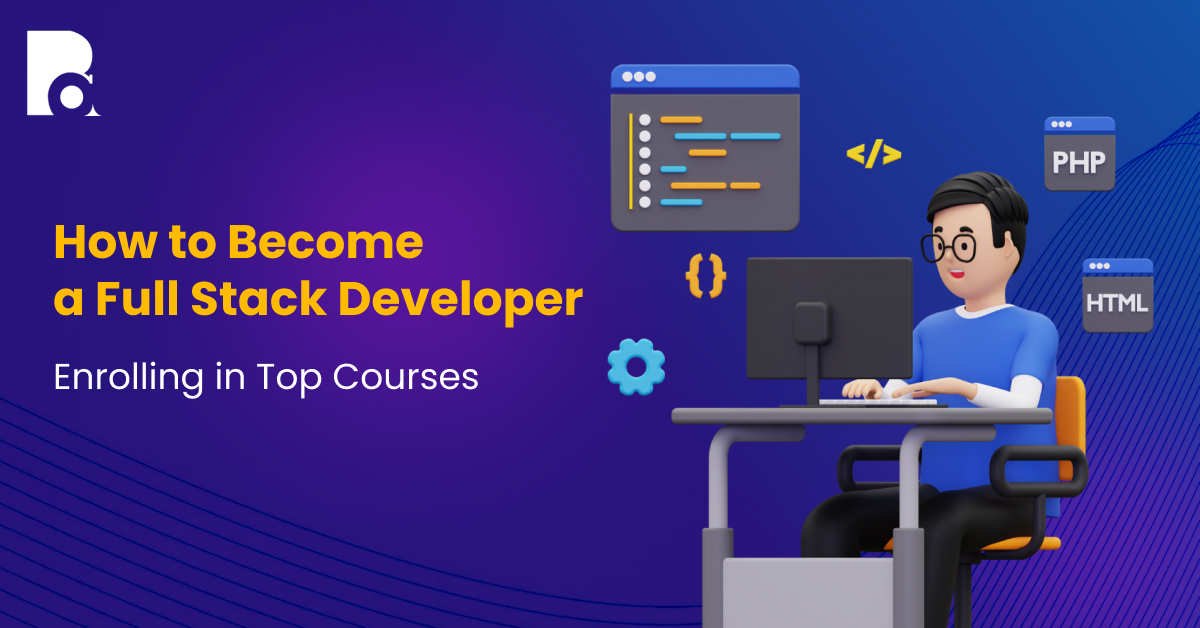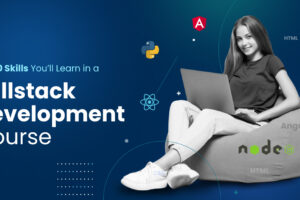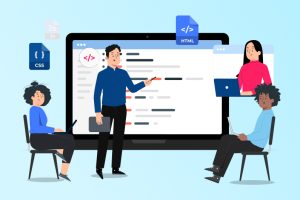
How to Become a Full Stack Developer – Enrolling in Top Courses
Among the many IT courses, full-stack development is the most versatile and most rewarding career path in the tech industry. Plus, the best part is it’s not limited to only people who’ve had formal education. So, if you are wondering how to become a full stack developer, you’ve come to the right place.
Full stack development also presents an exciting skill-building opportunity for people seeking to upskill. From a job search perspective, it proves to be lucrative since one gets to master front-end and back-end technologies, thus giving them brighter prospects while job hunting.
Many students want to become certified full stack developers as the demand for multi-skilled developers has been rising exponentially. High quality courses allow them to speed ahead in the race, even if many others are vying for the position. The worth goes beyond monetary value, equipping them to handle different projects independently.
The Role of a Full Stack Developer in a Nutshell
Businesses seek full stack developers as they are proficient in both client-side and server-side of web applications. Essentially, they ensure that everything from the UI to the base server infrastructure works together. It goes further than just coding in multiple languages. You would need to realize how every layer of development connects, figuring out how to perk up website performance without neglecting user experience.
If you were a full-stack developer given the task of making an e-commerce site, you may want to make sure that product pages loaded incredibly fast, the checkout process was smooth, and that the server could handle thousands of orders without crashing. You’ll probably use something like React for the frontend, Node.js for the backend, and something like MongoDB or MySQL to store all that product and user information. It’s more than technical skills, your job is to think holistically, identify problems across all layers, and continually refine the architecture of the application to make it faster, more scalable, and easier to maintain.
Who Can Apply For a Full Stack Development Course?
- Graduates from any field who are enthusiastic about technology.
- Students studying or have studied Computer Science or related areas.
- Professionals who have some coding experience and want to transition into a web development career
- Active job seekers who want to acquire additional skill sets and enhance their chances of being hired in the technology sector.
What Are the Perks of Being a Certified Full Stack Developer?
Becoming a certified full stack developer opens the doors to a wide range of exciting opportunities. First off, there’s demand. Full stack developers are highly sought after because they can work across the entire development lifecycle. Startups in particular value full stack developers since they reduce the need for many separate specialized hires and you’re therefore a more flexible and valuable asset.
In terms of salary, full stack developers often earn competitive wages. Since a full stack web developer salary ranges from 5 to 9 LPA in India, many graduates have chosen to pursue this lucrative IT career. This of course depends on the candidate’s experience and location. Even entry-level full stack developers command some impressive salaries, often higher than the ones commanded by the specialized front-end or back-end professionals.
Once one masters both sides of the stack, freelancing becomes an option that becomes viable and profitable. Many full stack developers are able to work in a remote fashion, with flexible hours and pick projects according to their interests. Not to mention, technology is constantly evolving; therefore, there is always room for professional as well as financial growth.
Front-End Development Skills for Designing Logical User Interfaces
Primarily front-end development is about the UX, the user experience. You will work with all elements the user will view and interact with on a webpage: buttons and images, forms and navigation menus. The technologies that are core to developing front-end applications are the HTML, CSS, and JavaScript technologies. HTML structures the content of a webpage, while its presentation is made visually appealing using CSS. JavaScript revives the page to make it interactive- submitting forms, animations, loading dynamic content, etc.
But simply knowing these basics is not enough. Modern front-end development often includes the usage of libraries and frameworks like React, Angular, or Vue.js. The latter, using reusable and scalable components, simplify the development of highly complex applications. You’ll also need to master responsive design, ensuring that your web applications look and function well on all devices, from smartphones to desktops.
A certified full stack developer does not just write code but also optimizes it. That includes writing clean, maintainable code and keeping load times low by using techniques like lazy loading, image optimization, and efficient DOM manipulation.
Back-End Development Skills for Robust Server-Side Functionality
The back-end deals with all the functionalities that happen behind what the user is seeing and interacting with. Everything related to application logic, database interactions, and server management falls under the expertise of a back-end developer.
Node.js, Python, Ruby, PHP, and Java are languages typically used for developing the back-end. Since each project has different requirements, every one of these has its own strengths. Node.js is well suited for real-time applications because its architecture is non-blocking, event-driven. Python is applied to machine learning and data analysis of the application because it has simplicity and readability. The end result is the same, regardless of the language being applied, the application should run smoothly and securely even with large user loads.
Developers who do full stack work will need to deal with server management, structuring them to handle service requests, and manage high-level performance and security. Knowing about application programming interfaces is key to making any progress, as APIs are what enables the communication between the front-end and the back-end.
Working with Databases for Structured Data Management
Most web applications rely on databases to store everything from user information to product inventory. As a full-stack developer, you will be capable of handling the task of database management and knowing when it makes sense to use SQL-based databases like MySQL or PostgreSQL in contrast to NoSQL databases like MongoDB or Firebase.
SQL databases are relational; in them, data is stored in tables and relationships are made between tables. NoSQL databases store data in more flexible, often unstructured forms, making them well adapted to handle large amounts of real-time data, like social media platforms or online gaming systems.
Regardless of the type of database you work with, you’ll need to know how to design efficient database schemas, write queries to retrieve and manipulate data, and ensure data security through proper user authentication and encryption techniques.
Mastering a Tech Stack (e.g., MERN, MEAN, LAMP)
A tech stack is the combination of technologies used to develop a complete web application. MERN is the go-to tech stack that takes into account MongoDB, Express.js, React.js, Node.js. Other popular combinations include MEAN (MongoDB, Express, Angular, Node.js) and LAMP (Linux, Apache, MySQL, PHP). All of these have their strengths and weaknesses, so the selection comes down to the sort of application that is being crafted.
The MERN stack, for example, has had more success in recent web applications due to the fact that it is all-JavaScript-based. This normally tends to be pretty handy for developers who want to do a bit of both on perhaps different projects without having to learn a completely different language. LAMP, on the other hand, has long been referred to as the classic web stack that has powered most of the web; thus, it continues to be very popular today in web development in building dynamic websites.
Mastering a tech stack is more than just learning the individual technologies—it’s about understanding how they interact. You’ll need to know how to set up a development environment, configure the different components to work together, and optimize performance across the entire stack.
Real-world Projects and Impressive Portfolios
Learning the theory is one thing, but building projects is where you really develop your skills. Employers don’t just want to see that you know the syntax of a programming language; they want to see how you can apply that knowledge to solve real-world problems.
Start by building simple projects—like a personal website, a to-do list app, or a blog. As you gain more confidence, you can take on more complex projects, such as building a complete ecommerce site, a social media platform, or a real-time chat application. Each project should demonstrate your ability to work with the full stack, from creating a responsive user interface to designing the database schema and deploying the application.
Document your projects in a portfolio, and make sure the code is clean and well-organized. Use GitHub to share your code and Git to track your progress. A well-curated portfolio can make a significant difference when applying for jobs, showing future employers that you’re not just capable of writing code but of building complete, functional applications.
Things To Look Forward To From a Full Stack Developer Course In Kolkata?
On average, Full Stack Developer course fees may come to somewhere between ₹40,000 and ₹45,000 for a duration of 6 months. The value for money is excellent given the amount of skills acquired. These courses come under the mentorship of industry people, who have substantial work experience in actual firms, thus bringing real-world techniques to the classroom.
Many institutes also offer learning options as offline, online, or a mix of both to suit the individual’s preferences and schedules. What sets these courses apart is that the training will be done through live, hands-on learning experience—you actually work on live projects so that you can apply whatever knowledge you gain from them in an interactive, engaging environment.
As a student enrolling for these courses you would get individual support through one-to-one doubt-clearing sessions so you actually know what you are doing with even the most complex concepts. This intense, practical training puts you well in a rapidly growing tech sector.
100% placement assistance is provided by many institutes that offer Full Stack Developer Courses in Kolkata. This eases the process of getting your first job. In today’s cutthroat job market, having industry professionals guide you in certain situations, providing resources for resume building and interview preparation makes all the difference.
In Kolkata, where the tech industry is booming, these courses often have partnerships with local and international companies. They help candidates by connecting them with job openings that align with their skills and interests. You’ll get insights into what employers are looking for and receive one-on-one coaching to polish your technical skills and interview technique. As a job seeker looking for a high-paying IT career, your best option would be to get enrolled in a Full Stack Developer course in Kolkata. You will get a jump start for a fulfilling career in the tech world.
Course providers with strong industry ties can even offer internship opportunities, providing you with hands-on experience and the chance to build your portfolio further. By the time you complete the course, you’re not just a full stack developer—you’re a job-ready candidate with the connections and support you need to succeed.



